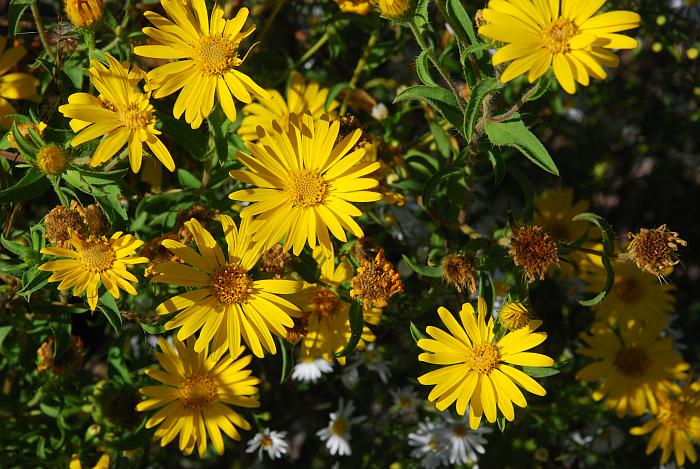Heterotheca camporum var. camporum
Golden Aster

Native
CC = 1
CW = 5
MOC = 25
© SRTurner
Heterotheca camporum var. camporumGolden Aster | |
 |
Native CC = 1 CW = 5 MOC = 25 |
© SRTurner |
|
Family - Asteraceae/Astereae Stems - To 0.8 m, ascending to erect, usually branched, moderately pubescent with long, spreading hairs with pustular bases, and minute appressed or curved hairs, sometimes modestly minute-glandular.
Leaves - Alternate, with lower leaves usually wilted at flowering. Stem leaves reduced upward, sessile. Blades simple, essentially entire, to 7 cm, narrowly oblong-lanceolate or oblanceolate, sometimes clasping the stem, often somewhat curved and contorted, surface and margins hairy and roughened, often glandular.
Inflorescences - Mostly solitary heads at branch tips. Involucre - Involucres 7-10 mm long, the bracts in 3-6 unequal, overlapping series, narrowly lanceolate to nearly linear, sometimes purplish-tinged at the tip, the green central stripe usually easily observed, moderately hairy, sometimes sparsely glandular.
Heads - Receptacle flat or slightly convex. Ray florets 15-35, pistillate, the corollas 11-15 mm long. Disc florets 25-65, perfect, the corollas 5.0-6.5 mm long, glabrous or nearly so. Pappus of the ray and disc florets similar, consisting of an outer series of several minute scales 0.2-1.0 mm long and an inner series of 25-45 bristles 5-7 mm long, these usually brown at fruiting.
Fruits - Fruits of the ray and disc florets similar, 1.5-4.0 mm long, somewhat flattened, 3- or 4-nerved on each face, hairy.
Flowering - July - October. Habitat - Sand prairies, glades, forest openings, streambanks, railroads, disturbed areas. Origin - Native to the U.S. Other info. - This plant, belonging to var. camporum, is by far the most common variety of H. camporum in the state. Relative to var. glandulissima, it is shorter, hairier, less glandular, and less weedy. It prefers sandy soils and is found in scattered locations in the southern half of the state. Photographs taken at Taum Sauk State Park, Iron County, MO, 9-27-2012; near Pacific, St. Louis County, MO, 7-24-2012, and on Ellis Island, St. Charles County, MO, 7-3-2017 (SRTurner). |